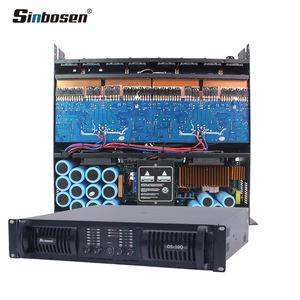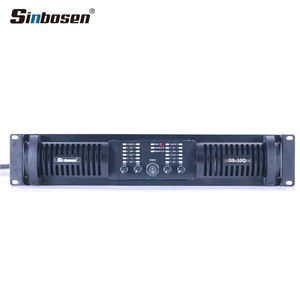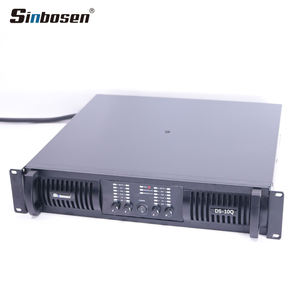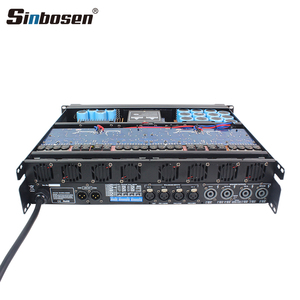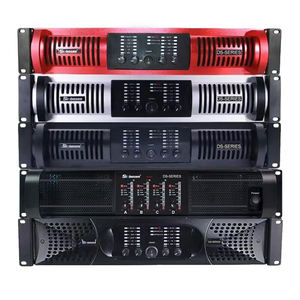Types of 4-channel Mixer Amplifier
4-channel mixer amplifiers are available in several types, each with its specifications that serves a unique sound requirement. Below are the most common types of these amplifiers found in the commercial audio market.
Digital Mixer Amplifiers
Digital amp speaker units offer high-quality audio processing, unlike analog amplifiers. They include integrated features such as Bluetooth connectivity, digital signal processing (DSP), and various audio settings. DSP allows the user to adjust the audio frequency to fit the acoustics of a given space.
Digital amplifiers also have a more flexible channel system, allowing the user to add more input configurations like USB or optical. This flexibility makes them ideal for businesses needing adaptive sound systems, restaurants, and conference centers.
Commercial-grade Mixer Amplifiers
The commercial-grade amp and speaker system are designed for heavy-duty or continuous operation in business environments. These amplifiers come with more power, often 100 watts and above, and many input channels to cater to large setups.
These amplifiers are often housed in rack-mountable cases for ease of installation in professional areas like auditoriums, conference rooms, and retail outlets. They are built for durability, quality audio, and operational efficiency in various demanding commercial environments.
Bluetooth-capable Mixer Amplifiers
This feature helps reduce the number of wires because the audio sources, like phones, will be connected wirelessly. It is very convenient, especially for users who frequently change audio sources or make presentations. Bluetooth amplifiers are useful in casual environments where quick and easy connectivity is important.
Audio Mixer Amplifiers
These amplifiers come with an integrated mixer that allows the user to control several audio inputs simultaneously. These inputs can be microphones, musical instruments, and other audio sources. They are perfect for live events, speakers' sounds systems, and venues where multiple audio sources need to be managed simultaneously. Other than that, they are also ideal for professional applications such as broadcasting, theatre, and live music shows.
Specifications and Maintenance of 4-channel Mixer Amplifier
Key Features of 4-channel Mixer Amplifier
They Include:
- Channels: As the name implies, a 4-channel mixer amplifier has four channels that allow the user to connect various audio sources like microphones, instruments, and playback devices. This capacity makes them suitable for moderate to heavy use environments such as small auditoriums or restaurants.
- Wattage: The wattage varies depending on the model and brand. However, it ranges between 20 to 100 watts per channel at an 8-ohm rating. Higher wattage means it can drive larger speakers for more powerful sound amplification.
- Impedance Compatibility: Therefore, an imagination of a home theater system consists of several models of this amplifier with varying impedance of between 2 and 16 ohms. This means the amplifier can work well with a wider range of speaker configurations.
- Audio Inputs: These mixers have various inputs, including XLR and 1/4" jacks, RCA, and line level. This variety means one can connect a broad spectrum of audio equipment from professional to consumer grade.
- Equalization: Most 4-channel amplifiers come with a built-in equalizer. This feature gives one the ability to adjust frequency ranges for each channel, improving audio quality according to the acoustics of the space.
- Feedback Control: Some models come with feedback suppression technology that reduces or eliminates feedback when using microphones. This is particularly useful in live performance settings where feedback can be distracting or damaging.
How to Maintain and Repair 4-channel Mixer Amplifier
- Regular Cleaning: Dust, grime, and other buildups can affect the function of an amplifier. Regularly cleaning one will increase the life of the device. Use a soft, dry cloth to wipe the amplifier's surface and avoid using damp cloths on the device.
- Check Connections: Regularly check all the wire connections to ensure they are tight and secure. Loose wires can lead to poor audio quality and even damage to the mixer amplifier. Always disconnect the amplifier before going to check and tighten the cables.
- Software Updates: One may need to run updates on digital or Bluetooth amplifiers. These updates are often necessary for the optimal running of an appliance. Check the manufacturer's website for any available updates and detailed instructions on how to perform them.
- Heat Management: Amplifiers can be damaged by overheating. Ensure the amplifier is placed in an open area with sufficient airflow. Avoid placing other devices on top of the amplifier as this will block airflow and many other things.
- Professional Servicing: The amplifier should be taken to a technician for professional servicing at least once a year. This will help spot all the hidden issues, and a professional will do the maintenance. Amplifiers that are used extensively should be serviced more often.
Commercial Use Scenarios of 4-channel Mixer Amplifier
Sound Systems for Public Speakers
An amplifying system for a public address system commonly found in schools, theaters, and conference centers is a 4-channel mixer amplifier. Since the amplifier can handle four audio sources simultaneously, it is ideal for environments where numerous microphones and other audio sources need management.
Audio-Visual Systems in Managed Environments
In large retail stores, auditoriums, or houses, the 4-channel amplifier blends with the A/V system to provide background music and announcement capabilities. The amplifier's wattage allows it to power large or several installed speakers for comprehensive audio coverage.
Broadcasting and Media Production
They are used in broadcasting or recording studios to monitor and mix several audio inputs, such as microphones, instruments, and media playback. The integrated mixing and amplification capabilities streamline operational workflows in professional audio environments.
Commercial Installations
In commercial Spaces, the 4-channel amplifiers are installed as part of a sound system in restaurants, retail stores, and transportation hubs. The amplifiers in these environments ensure that announcements, music, and other audio are efficiently distributed throughout the space.
Live Event Production
These types of amplifiers are also used in live event production, whether a concert or a corporate event. These amplifiers mix and amplify multiple audio inputs from microphones and instruments and ensure powerful, clear sound for any audience size.
Buyer Guide for 4-channel Mixer Amplifier
Factors to Consider
- Power Output and Wattage: Select an amplifier with enough power to produce the desired volume without distortion. The wattage will depend on the speaker used and the size of the area that needs to be covered.
- Sound Quality: Look for amplifiers with features like equalization and DSP that enhance audio clarity. These features will help tailor the sound to certain environments.
- Number of Channels: Ensure the amplifier has enough channels to handle the number of audio sources. A 4-channel amplifier will be enough for four inputs but could be more with 8-channel amplifiers if more audio sources are needed.
- Input and Output Options: Check that the amplifier has the necessary input types, like XLR or RCA. This ensures compatibility with existing audio equipment. Also, consider the output power to compatibility with the installed speaker system.
- Durability: Pick commercial-grade amplifiers for their ability to last rigorous daily usage. Look out housing made of metal and components meant for thermal management. These features will ensure it lasts long enough for the user.
- Installation: Depending on the type of the unit, one might need to mount the amplifier in a standard audio rack or fit it in some other space. Hence, consider the weight and housing style of the unit to eliminate unnecessary complications.
Avoid the Following
- Ignoring Power Needs: Ignoring the power needs of the amplifier can generate insufficient or excessive power. Insufficient power results in low volume levels and poor sound quality. At the same time, excessive power can damage connected speakers due to distortion. Just balance the amplifier and speaker power ratings to avoid these problems.
- Overloading Channels: While 4-channel amplifiers are designed to handle multiple audio sources, avoid overloading them by pushing beyond their capacity. Doing so will lead to distortion, reduced sound quality, and possible damage to the amplifier and connected devices.
- Neglecting Maintenance: Failing to maintain an amp mixer causes reduced performance over time. For this reason, users should regularly clean and check the mixer to avoid overheating, dust accumulation, and signal interference. Also, one should ensure cooling will extend the life of the amplifier and improve the quality of sound produced.
- Skimping on Cables: Low-quality connection cables negatively impact the sound quality. Poor cables can cause interference, signal loss, or reduction in sound clarity. Invest in decent quality RCA/ XLR cables to ensure there is efficient signal transmission between the audio sources and the amplifier.
- Overlooking Speaker Compatibility: Amplifiers and speakers do not always work together although they may be of the same brand. The wattage and impedance of the speakers should be compatible with those of the amplifier to avoid damage. Apart from that, check the manufacturer specifications for guidance on achieving proper connectivity and compatibility of these two elements.
- Ignoring Placement and Ventilation: Avoid placing the amplifier in a cramped space with poor airflow. A poorly ventilated amplifier will always run hot, and this will lead to performance loss and eventual damage to internal components. Ensure there is sufficient airflow around the amplifier to keep it cool to avoid these problems.
Q and A
What is the advantage of a 4-channel mixer amplifier over the 2-channel one?
Providing four channels allows users to manage four distinct audio sources simultaneously. This capability makes it ideal for environments where many microphones, instruments, or other audio sources need mixing. A 2-channel amplifier, on the other hand, cannot manage these many sources at a time.
How can one tell that an amplifier is overheating?
There are a few common signs that an amplifier is overheating. For instance, one will find the amplifier hot to the touch, especially around the heat sinks or vents. Further, it may slow down; many modern amplifiers have built-in thermal protection that reduces performance to avoid damage when it is too hot. Last, there may be distorted sound within music or audio. When the amp overheats, it cannot produce clear sound. Instead, the musicians will detect distorted or faint audio. Therefore, to avoid all these signs, it is important to ensure there is enough ventilation around the amplifier. Additionally, avoid overloading it with too much power. Placing the amplifier in an open area and avoiding enclosed spaces will also help eliminate these problems.
Can a 4-channel amplifier be connected to a smartphone wirelessly?
Some 4-channel amplifiers include Bluetooth or Wi-Fi connectivity, allowing audio streaming from smartphones and other devices without physical connections. This feature is handy for background music in commercial spaces or for easy audio playback in retail environments.
Are mixing amplifiers worth it?
Yes, they are worth it. Amplifiers are preferred in special applications because they make audio from multiple sources easier to manage while providing sufficient power to the installed speakers. The versatility and features of these amplifiers make them handy for various environments, such as live events, commercial spaces, and more.


























































































































































































